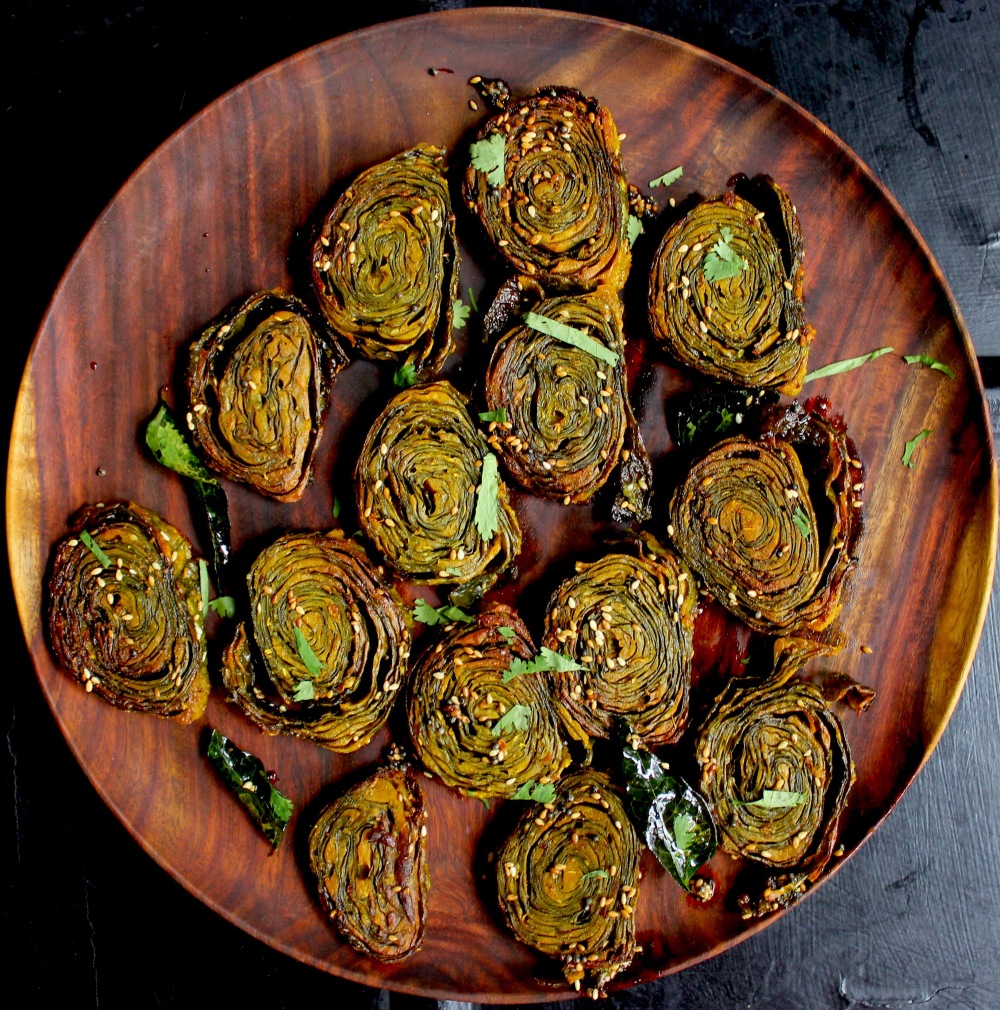 Last November, I taught a series of gluten-free cooking classes to children with celiac’s disease. The class was generously hosted in the beautiful kitchen of one of student’s parents. These parents were amazing cooks themselves, but had realized that their daughter did not want to learn to cook from them, so they brought me in. On the day of our last class the mom, who was Indian, sent me home with frozen Patra. Her husband had made this special dish and somewhat complicated dish from scratch to avoid the wheat starch that finds its way into asafoetida (one of the spices used in the dish). She instructed me to cut the green roll into slices and fry them. It was really delicious and I wanted more. I discovered that my favorite Indian snack shop, Rajbhog served this dish! Ragbhog fries theirs up with black mustard seeds, sesame seeds and curry leaves and served it with a mint chutney. It was sublime, but I was worried about possible asafetida wheat starch contamination, so I decided that I would try to make it myself!
Last November, I taught a series of gluten-free cooking classes to children with celiac’s disease. The class was generously hosted in the beautiful kitchen of one of student’s parents. These parents were amazing cooks themselves, but had realized that their daughter did not want to learn to cook from them, so they brought me in. On the day of our last class the mom, who was Indian, sent me home with frozen Patra. Her husband had made this special dish and somewhat complicated dish from scratch to avoid the wheat starch that finds its way into asafoetida (one of the spices used in the dish). She instructed me to cut the green roll into slices and fry them. It was really delicious and I wanted more. I discovered that my favorite Indian snack shop, Rajbhog served this dish! Ragbhog fries theirs up with black mustard seeds, sesame seeds and curry leaves and served it with a mint chutney. It was sublime, but I was worried about possible asafetida wheat starch contamination, so I decided that I would try to make it myself!
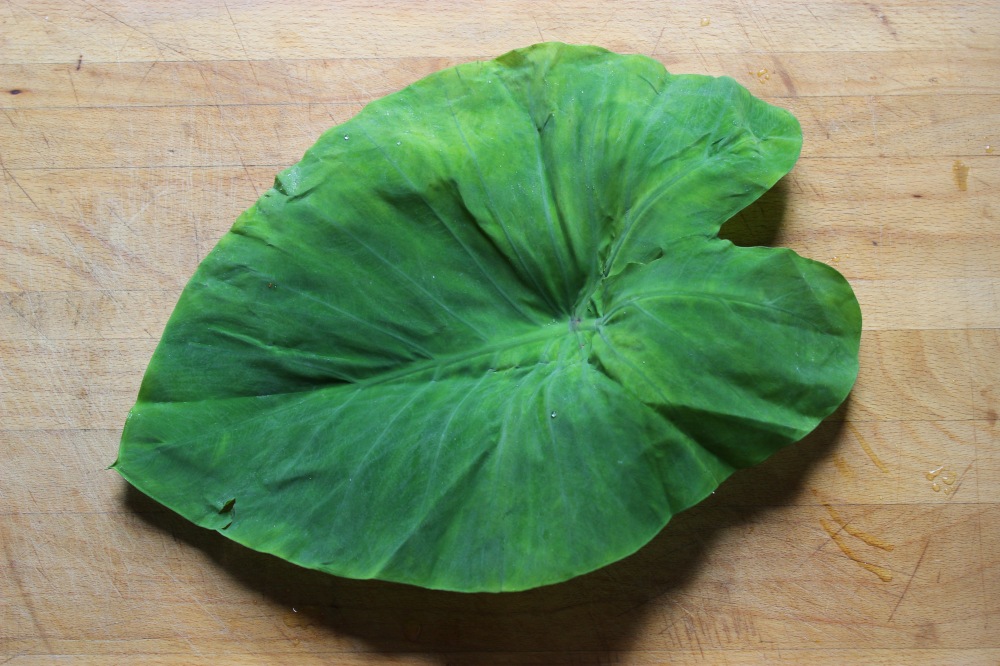
The first challenge was figuring out where to get the special green leaf used in the dish. My student’s mother had smuggled the cutting of the colocassia leaf (aka arbi) from her mother’s farm on India and was growing it in her back yard in Brooklyn! I asked the proprietor of Rajbhog if he knew where to buy the special leaves used in the dish. He directed me toward the Patel Brothers grocery but warned me that they didn’t always carry them.
Patel Brothers did have them that day and when I got them home I realized that I knew this leaf. I grew up in Hawaii, where this plant is called Taro! Also, they sell Taro leaf in the Caribbean groceries in my neighborhood under the name Callaloo. Callaloo is the name given to a variety of greens, so if you are looking for taro in a Caribbean grocery examine the leaves carefully to make sure you’ve got the variety with the big heart-shaped leaves.
When they are raw, taro leaves are quite meaty and waterproof , like collard greens. Unlike collards however, they soften up quickly and easily. All the same, I thought that collards might be a good substitute green if you can’t find taro. I tried it out and it worked beautifully! My collards were relatively small, young and fresh from my farmshare. I think the larger, older leaves would be too tough.
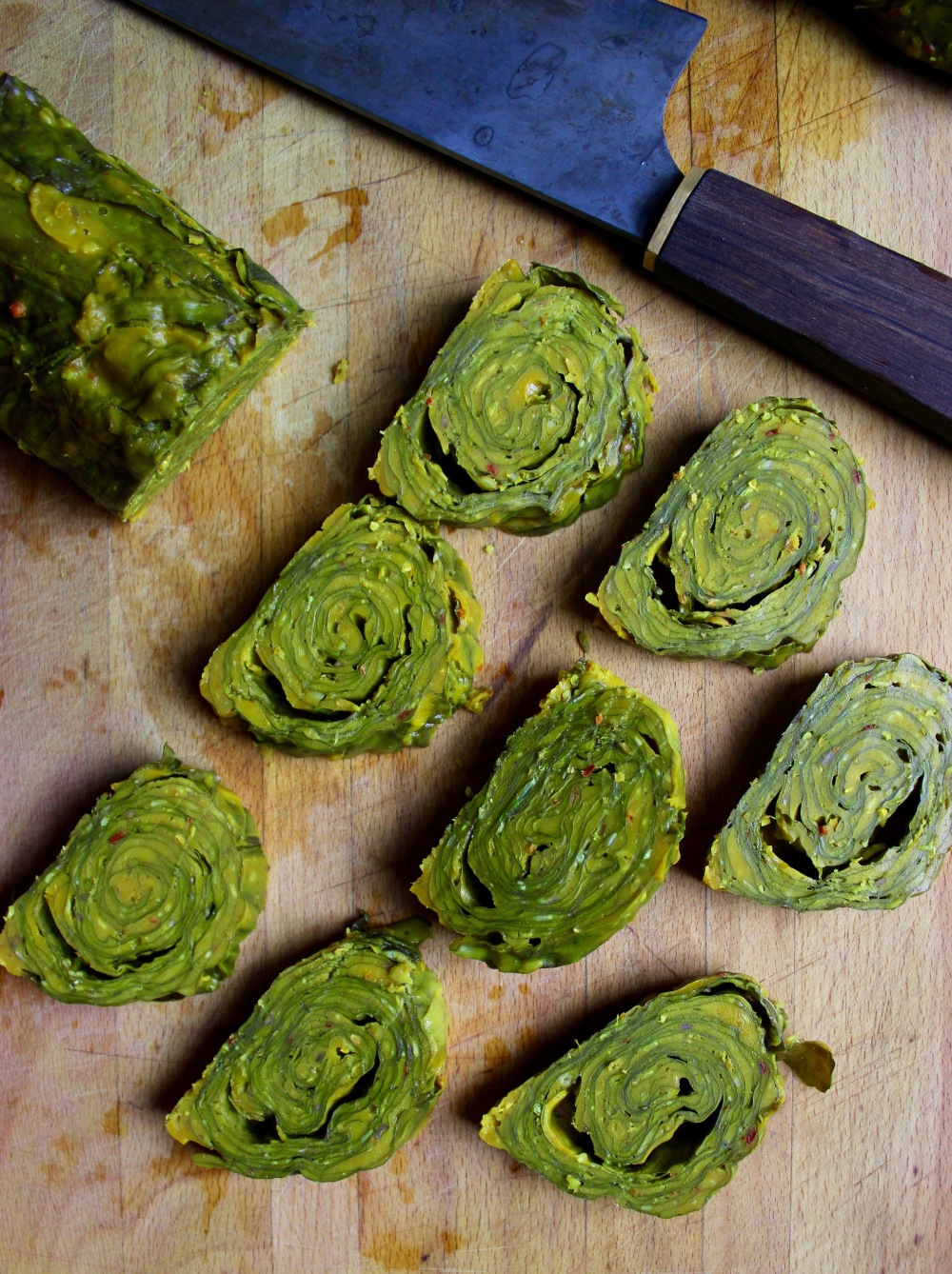 The greens get layered with a spicy, sweet, tangy, savory chickpea flour paste. I looked at dozens of recipes on-line and most of them are very similar to each other. I tried two weird ones (one with onion and one with banana) before deciding that the basic recipe was best.
The greens get layered with a spicy, sweet, tangy, savory chickpea flour paste. I looked at dozens of recipes on-line and most of them are very similar to each other. I tried two weird ones (one with onion and one with banana) before deciding that the basic recipe was best.
While researching this dish, I learned that it is from the Gujarati region. It turns out that many of my favorite Indian foods are from this region. I have been obsessed lately with Meera Sodha’s recipes. Her family is Gujarati by way of Uganda. I cannot recommend her cookbooks enough. When I get to travel to India again, I want to go to Gujarat to eat and learn to cook.
There are many beautiful, helpful recipes on-line with helpful step by step photos if you find mine at all confusing. This one has nice photos and so does this one. No photos in this one but I really liked their rolling pin method for softening the tough spine of the leaf. My post is meant to be helpful to anyone who is looking for substitutions ingredients that are hard to find in North America. Also, sometimes the recipe posts from India assume that you know how to deal with certain ingredients that are usual there but unfamiliar to cooks from elsewhere. So, I’ve tried to be more explicit with those instructions here.
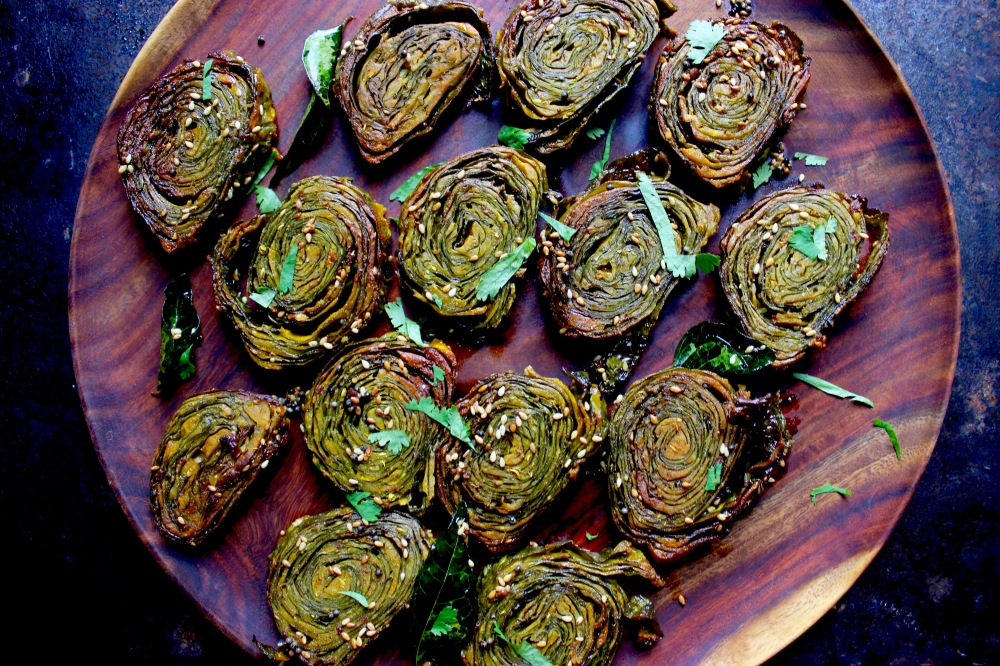 MAKING PATRA IN A NORTH AMERICAN KITCHEN
MAKING PATRA IN A NORTH AMERICAN KITCHEN
Ingredients
- 6 large or 12 small colocassia (aka arbi, aka taro) leaves OR small tender collard greens
- 2 Tablespoons Tamarind pulp. I buy the bricks of tamarind pulp with the seeds still in it rather than the concentrate. They sell the bricks at both Indian and Caribbean groceries. It is cheap in this form and I find the flavor to be better than in the concentrated form. It keeps forever in a sealed bag in the fridge. Don’t think there is a good substitute for the tamarind in this recipe.
- 1 and 1/2 cups chickpea flour (aka garbanzo bean flour or besan)
- 2 teaspoons coriander powder
- 1 teaspoon cumin powder
- 1 teaspoon turmeric powder
- 2 teaspoons sesame seeds
- 2 Tablespoons Jaggery. Jaggery is palm sugar and is sometimes called Gur. Brown sugar is a fine substitute, although jaggery is nice if you can get it.
- 1 teaspoon minced fresh ginger
- 1 teaspoon minced green chili pepper (I used jalapeño and it was fine for preferred spice level)
- salt to taste
- oil to fry
- 1/2 teaspoon asafoetida. If you are gluten-free do not buy this in powdered form as it is cut with wheat starch. I buy it in lumps and pound it into powder in a mortar and pestle. I love this flavor, but it not everyone’s cup of tea. The dish would still be delicious without it.
- 1 teaspoon mustard seeds (black ones if you can get them)
- 1 tablespoon sesame seeds
- a few fresh Curry leaves (optional, but nice if you can get them)
- a few leaves of cilantro
Preparing the leaves
- Wash the leaves and trim the stems off.
- Roll over the backside of the leaves to soften the part of the stem that extends into the center of the leaf.
- Put all of the large leaves in one pile, the small leaves in one pile and damaged leaves in another pile.
Preparing the paste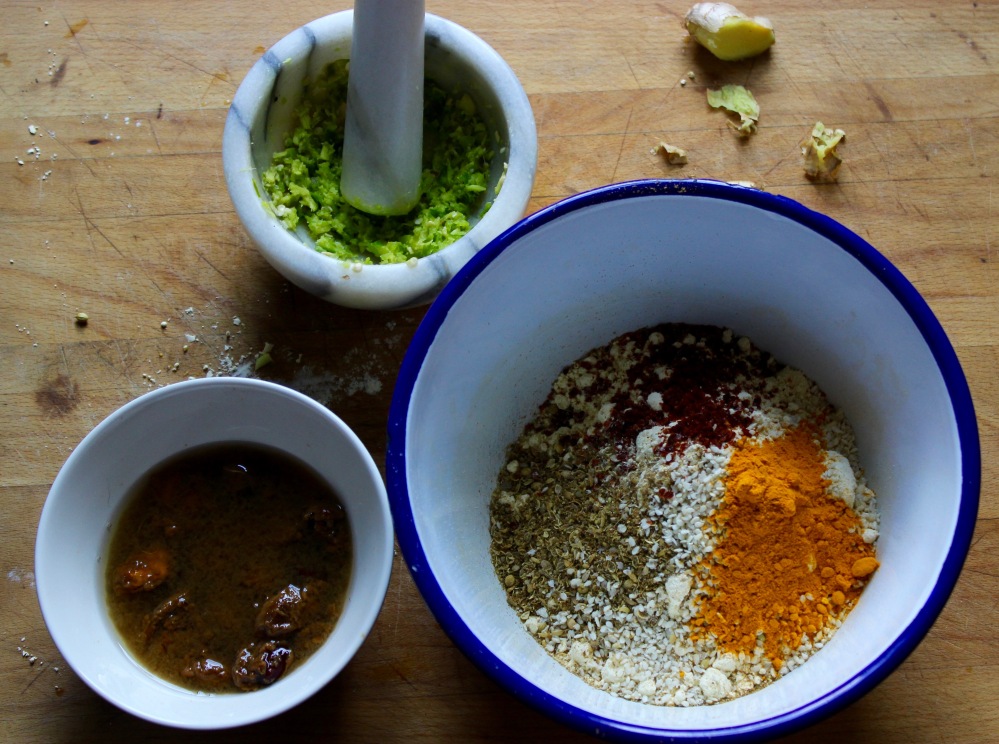
- Bring some water to a boil in a kettle.
- Pour about 1/2 cup of boiling water over the tamarind pulp in a small bowl and let it stand.
- Combine the chickpea flour, coriander, cumin, turmeric, sesame seeds and jaggery or brown sugar in a medium bowl.
- In a food processor or mortar and pestle, process the fresh ginger and green chili pepper into a paste. Add the ginger chili paste to the flour and spice mix.
- Using your fingers, work the tamarind pulp off of the seeds. Strain the liquid through a sieve into the flour and spice mix. Stir to combine and add more water if needed to make spreadable paste. Add salt to taste.
Making the Rolls
- Bring water to boil in a steamer.
- Choose a large, undamaged leaf and spread it with paste.
- Lay another leaf on top with the point facing the opposite direction. This leaf could be smaller or damaged. Spread it with paste.
- Add a third leaf, changing the direction of the point again. This one should be one of your smaller or damaged leaves, since it will end up in the center of the roll. Cover it in paste too.
- Slightly fold both of the long sides of the leaves up, then tightly roll.
-
Repeat with the remaining leaves and paste.
- Steam the rolls for 15-20 minutes. I use a plate on a baking rack in large pot with a lid. Allow the rolls to cool. They can be refrigerated or frozen at this point if you don’t want to eat them right away.
Finishing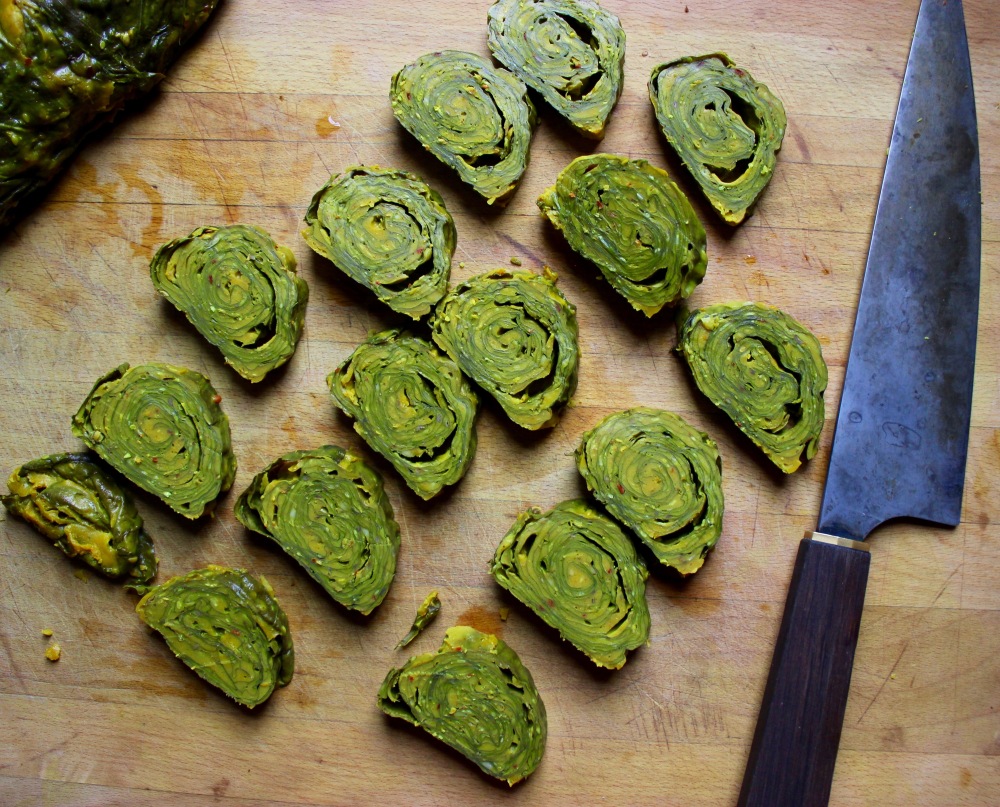
- Slice the rolls into 1/4″ inch rounds with a very sharp knife
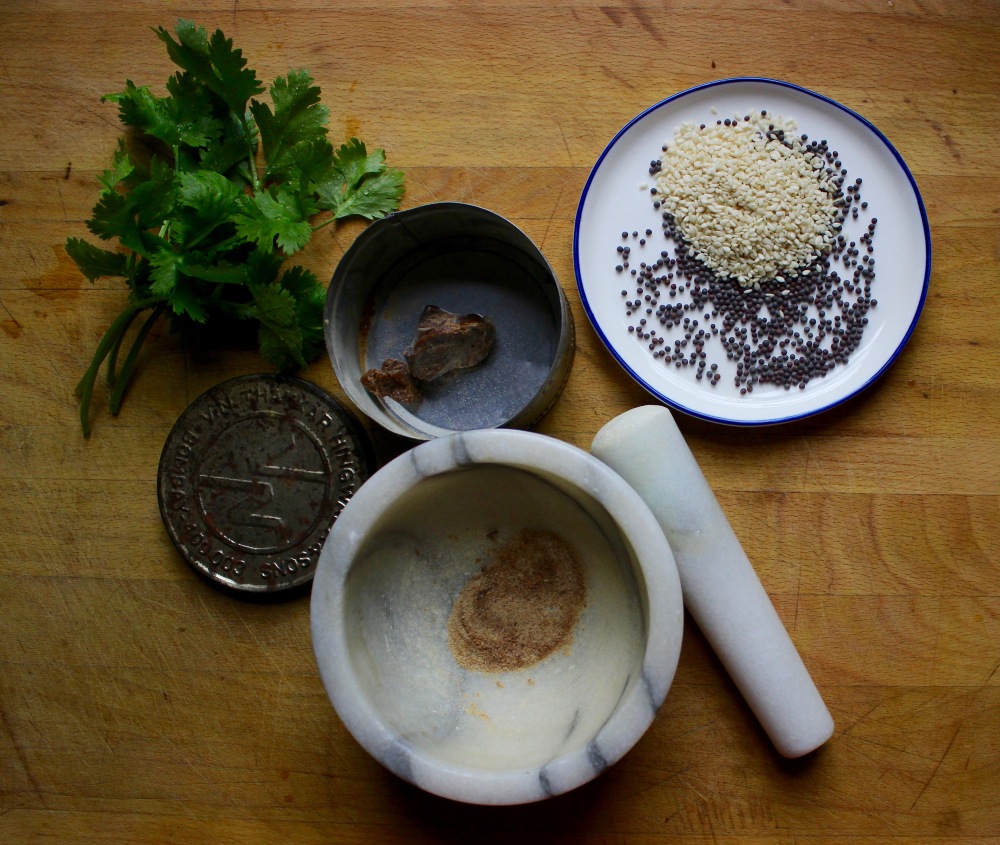
- Heat oil in a large skillet and add the black mustard seeds, sesame seeds, curry leaves (if using) and asafetida (if using).
- Add the sliced part and fry on the first side until they are crisp and golden. Flip them and fry on the other side as well. Add more oil as needed.
- Serve garnished with the fried oil and seeds and fresh cilantro and mint chutney (see recipe below).
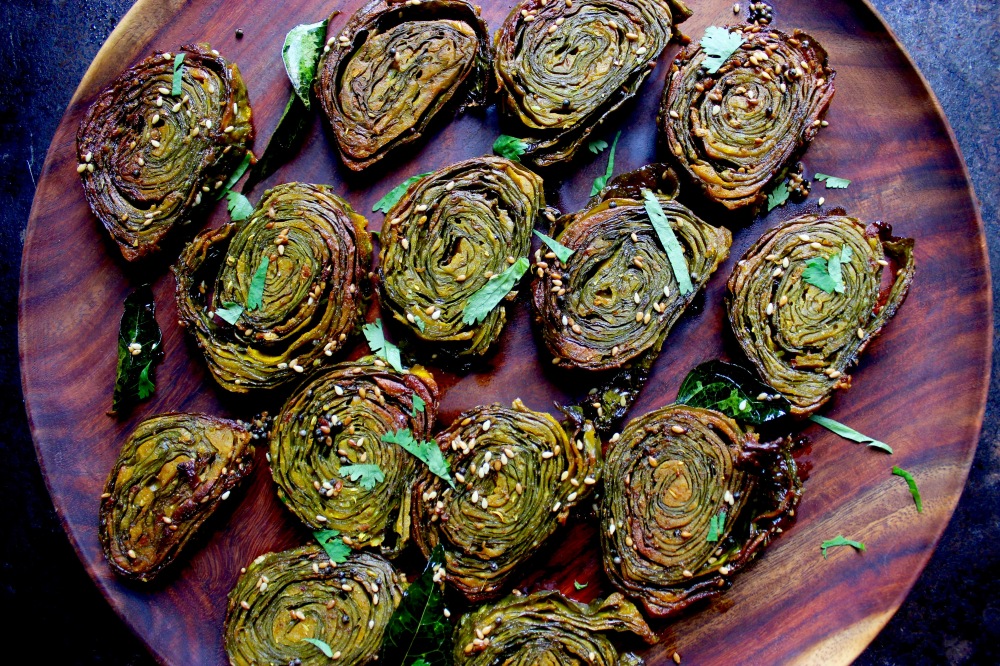
MINT CHUTNEY
You can use store-bought mint chutney, but I recommend trying this easy recipe adapted from My New Roots
- 2 cups fresh mint leaves
- 1 small clove garlic
- 1 teaspoon minced ginger
- 3 pitted medjool dates
- 1 minced jalapeno pepper
- 1/4 cup lime or lemon juice
- 2 Tablespoons olive oil
- salt to taste
- water as needed
Combine the mint, garlic, ginger, dates, jalapeno, lime or lemon juice and olive oil in a blender or food processor. Process until smooth adding water as needed. Season with salt to taste.
MORE INDIAN INSPIRED SNACKS

















Sounds yummy! I’ll show this to my friend Wahida. ❤️
Way cool, Erin! Love your recipes. But every time I’ve worked with taro leaves, they caused my laulau buddies and me to itch. I know you’re magical, but do you have some specific knowledge on the subject of itchy taro?
I know what you are talking about! Me too a bit. My understanding is that some people are really sensitive to it. Otherwise I’d eat it more often!
wow, They look so perfect… I really admire you for it, being an Indian, I know it takes lot of time in making but vanishes from plate within minutes…